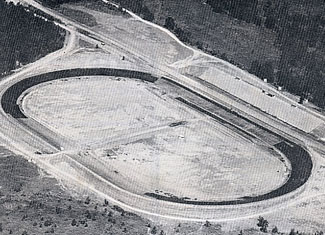
A look at Jefco Speedway (now Gresham Motorsporst Park) just prior to its opening in 1967.
By Brandon Reed
Posted in Feature Stories 8/27/10
When the green flag falls at Gresham Motorsports Park in Jefferson, Georgia on the night of Saturday, August 28, it will be another page in the NASCAR history books at the storied speedway.
NASCAR’s K&N Pro Series East is making its only Peach State appearance this year with a 150-lap event at the high-banked half-mile track. Drivers such as 2009 series champ Ryan Truex, Ty Dillon, Darrell Wallace, Jr. and Eddie MacDonald will be vying for the win.
But that’s just the latest piece of NASCAR lore to go into GMP’s history books. For much of its existence, the speedway has had involvement from NASCAR. In fact, the speedway remains one of only two still in operation in the state of Georgia that has hosted a NASCAR Sprint Cup event.
The speedway opened in July of 1967 as a NASCAR sanctioned facility. Track owners Hansel Wilson and Quentin Freeman had spent five years planning the track, which was located next to their existing drag strip outside of Jefferson, Georgia.
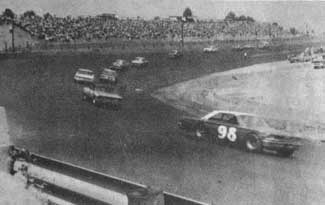
Jody Ridley (98) leads Curtis Turner into turn one during the inaugural event at Jefco Speedway.
The track was laid out as a high-banked half mile, with smooth, gradual transitions that transferred into blazing speeds and side-by-side racing.
The track opened as “Jefco Speedway”, a name combined of those of the two largest cities in the county, Jefferson and Commerce. The first event run on the track was a NASCAR Sportsman event called the “Tiger 200” in honor of Commerce’s high school football team, the Tigers.
Oddly enough, that race was won by journeyman driver “Tiger Tom” Pistone. Pistone outlasted legendary NASCAR driver Curtis Turner, who was piloting a car owned by Georgia Racing Hall of Fame member Dub Smith. Other Hall of Fame drivers taking part in the race were Bruce Brantley and Jody Ridley.
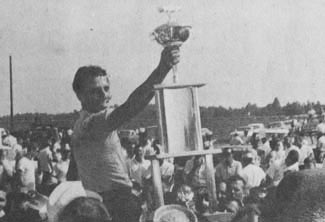
The NASCAR folks really took to the track, with several of the their divisions racing on the Jefferson high banks over the next two years.
In July of 1968, NASCAR’s Grand Touring division, which was made up of Pony Cars, made their first appearance at the speedway. Pole sitter Tiny Lund dominated the event, winning the 200-lap event in his 1968 Mercury Cougar. He bested Donnie Allison, “Little Bud” Moore, Harold Dunaway and Frank Sessoms to take home top honors.
NASCAR’s next appearance in Jefferson would be one of the biggest in history, as the half-mile Jefco track hosted the season finale for the Grand National series (now called Sprint Cup) on Nov. 3, 1968.
David Pearson started on the pole for the Peach State 200, but would surrender the lead almost immediately to second place starter Bobby Isaac. Isaac would go on to lead 144 of the event’s 200 laps, but a late race crash would leave him in ninth place at the end.
Cale Yarborough, piloting a hot Wood Brothers’ Mercury that day, led 51 laps to pick up the victory, followed by Richard Petty in a Plymouth. Pearson would finish third, with James Hylton and LeeRoy Yarbrough rounding out the top five.
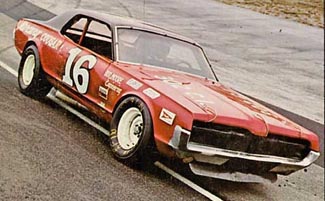
Tiny Lund dominated both NASCAR Grand Touring events held at Jefco Speedway.
The NASCAR Grand Touring series would return to the speedway on March 16, 1969 for the Bulldog 400, billed as a 400-lap event.
Tiny Lund dominated the event, jumping out front on the fist lap from the outside of the front row over pole sitter Pete Hamilton. Lund went on to take the win ahead of Frank Sessoms, Billy Yuma, Larry Wallace and C.B. Gwyn. It took just over two and a half hours to complete the race, which saw five cautions and 16 of the 24 starters go the distance.
NASCAR’s Grand National series would return to the high banks on November 2 for the third from the last race of the 1969 season for NASCAR’s premier division.
David Pearson took the pole again, with Bobby Isaac again on the outside. Pearson would manage to lead 62 of the race’s 200 laps, but it was clear that Isaac was on a mission.
After dominating the previous year’s event only to lose due to a crash, Isaac led 138 laps to dominate the event. His performance was slowed one by a caution, when James Hylton crashed on lap 98.
Isaac won the event over Pearson, with Richard Petty, LeeRoy Yarbrough and Neil “Soapy” Castles rounding out the top five.
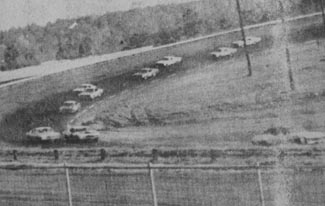
Drivers do battle off of turn four in what would turn out to be the last NASCAR Sprint Cup event held at Jefco Speedway in 1969.
The race had been a great one, but one of the most significant moments in the track’s history occurred after the event was over.
As the story goes, Big Bill France was very pleased with the layout and location of Jefco Speedway. It’s proximity to the northern half of Metro Atlanta, I-85 and the Jackson County Airport just across the street made it a prime location for a race track.
With that in mind, France sat down with owners Freeman and Wilson, and proposed that he bring each of his major touring series to the Jefferson half-mile twice a season forever more.
In exchange, he wanted a piece of the action in the form of a portion of ownership in the speedway. Reports conflict as to how much, but it’s ranged between 15 to 40 percent, depending on who’s telling the story.
How much didn’t matter, Freeman and Wilson had no desire to give away any portion of their track. They told France, in the strongest possible terms, that there would be no deal.
With that, Big Bill France packed NASCAR’s bags and said they would not be returning to Jefferson, Georgia any time soon.
It was a decision that would affect the future of Jefco Speedway, and damn near kill it over the next few years.
—
Without the NASCAR sanctioning the track had opened under, the track fought hard to survive over the next few years.
Attempts to run weekly shows just didn’t work. The track was too fast, and local racers found they would burn their equipment out trying to keep pace.
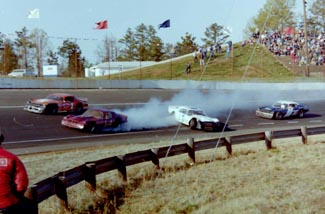
Drivers mix it up in turn one at Jefco in the early '80s. Photo courtesy the Robert Turner collection.
For a period of time in the mid 70’s, the track closed. A brief resurgence in 1977 under the promotion of Ray Newman was spotty at best, and the track closed again for the entirety of 1978, 1979 and 1980.
It reopened in 1981 under the promotion of Mac Simpson and L.C. Smith, with several All Pro series Late Model shows, promoted by Bob Harmon, was the salvation of the track. Drivers such as Randy Couch and Neil Bonnett put their cars in victory lane, with Georgia Racing Hall of Fame driver Ronnie Sanders setting a new track record of 17.89 at one show.
In 1982, after a 12-year absence, NASCAR returned to the Jefferson high banks.

Bill Elliott celebrates his 1982 win in the Katherine's Kitchen 200 with his father George (right) at Georgia Int'l Speedway. Photo courtesy the Robert Turner Collection
But there was already one big change at the track. The Jefco name, which had served the track since it’s opening in 1967, was abandoned. The track was now known as “Georgia International Speedway.”
The track reopened by hosting a NASCAR Grand American Late Model event. Mike Alexander would take the win in an event that would be the first of several Grand American races to be held at the track that year. Other winners in 1982 included Junior Niedecken, and Dale Earnhardt. Several other NASCAR drivers came to the track to compete in Late Models over the season, with David Pearson finally winning on the track he had twice won poles on. Georgia Racing Hall of Fame members Bill Elliott and Jody Ridley also picked up wins, including a victory for Elliott in the season ending Katherine’s Kitchen 200.
The influence of both NASCAR and Harmon’s famed All-Pro series was just what the track needed to get back on its feet. In June of 1983, Ron Neal took over ownership of the speedway, and announced it would only run special events for the remainder of the season. While NASCAR didn’t return to the track that year, their drivers did, with Neil Bonnett winning the 200 lap All-Pro event on August 13. Several NASCAR drivers would also take part in the first World Crown 300 that November. Dick Trickle won that event, which would go on to become the signature race for the speedway.
NASCAR would make their return to the track in 1985 by sanctioning the World Crown as part of its All American Challenge Late Model series. Mike Eddy took the victory in the event.
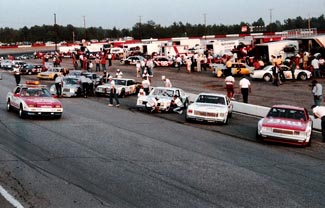
The field prepares to roll off for the 1986 NASCAR Grand National event at Georgia International Speedway. Photo from the Jim Coletrain collection, courtesy Chris Hussey
NASCAR would return in a big way to Georgia International in 1986, as the track played host to a Grand National (now Nationwide) series event on May 10 of that year.
Three-time NASCAR Sprint Cup champ Darrell Waltrip started the race from the pole, and would lead 179 of the 200 laps to grab the win over Dale Jarrett, Jack Ingram, Ronnie Silver and L.D. Ottinger. It would be the first of two big wins at the Jefferson half-mile for Waltrip that year, as he would bag the World Crown 300 in November as well.
Sandwiched in between was another NASCAR All-American Challenge series event in June, this one won by Mickey Gibbs.
1987 was another big year for NASCAR at Georgia International, as the track hosted two Grand National events as part of its season.
The first was on July 5, as Budweiser sponsored a 200-lap event. Second generation driver Larry Pearson started on the outside of the front row, alongside pole sitter Mark Martin.

Darrell Waltrip won the first NASCAR Grand National (now Nationwide) series event at Georgia International Speedway in 1986. Photo courtesy the Robert Turner collection
In the closing laps, Pearson would battle with former GIS winner Mike Alexander. Alexander led 58 laps to Pearson’s 56, but Pearson led the one that counted, the last one, picking up the victory. Dale Jarrett ran third, with Martin fourth and Rusty Wallace fifth.
Pearson would return to victory lane at Georgia International in the second NASCAR Grand National appearance of the year at the track on August 30, leading 129 of the 200 laps for the victory. L.D. Ottinger ran second with Mike Alexander third, Jimmy Hensley fourth and Darrell Waltrip fifth.
Waltrip would find his way to victory lane at Jefferson as well that year, winning the World Crown 300 for the second time. Waltrip became the first driver to win the Crown more than once.
Over the next few years, NASCAR would continue to be a force at the track in the form of Bob Harmon’s All-Pro Late Model series, now racing under the NASCAR banner. Drivers such as Jody Ridley, Jason Keller, Jeff Purvis, Rich Bickle and Billy Bigley, Jr. would all put their Late Models in victory lane between 1988 and 1993.
Late in 1993, the track was sold to a group of investors from Atlanta. Under the new ownership, the track would see it’s second name change. After the 1993 season ended, the facility would become known as Peach State Speedway.
NASCAR’s All Pro Series continued to frequent the Jefferson speed plant over the next two years. Jody Ridley picked up a win in 1994, while Mike Cope picked up the win in the NASCAR sanctioned World Crown 300 in 1995.
With the Hooter’s Pro Cup now becoming a strong force in southern stock car racing, NASCAR found itself losing dates at some of it’s usual venues. That was the case at Peach State Speedway, as the venerable All Pro series made it’s last appearance at the track on July 3, with Ron Young taking the last NASCAR sanctioned win at the half mile.
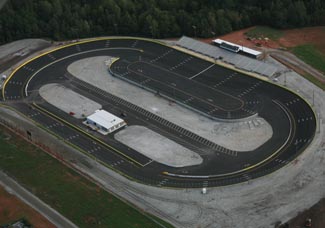
A look at the redisigned Gresham Motorsports Park from overhead. The track is now light years ahead of when it was Jefco Speedway. Photo courtesy GMP Media
It would make the last time NASCAR would make an appearance at the track. That is, until this year.
Following the end of the 2008 season, the Gresham family purchased Peach State Speedway, and gave the facility a much needed facelift.
The front and backstretches were flipped, with new grandstands and a new control tower being built. Trackside parking now surrounds the track, which boasts a new infield facility and a quarter-mile legends track.
The track itself was not altered in any way, other than the addition of a fresh coat of asphalt to the 43-year-old facility, now known as “Gresham Motorsports Park.”
While NASCAR’s return will culminate with the K&N Pro Cup event Saturday night, the signs of the sanctioning body’s return have been very evident.
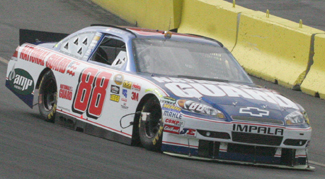
Dale Earnhardt, Jr. recently took practice laps around Gresham Motorsports Park, a track his father won on back in the early 1980s. Photo by Brandon Reed
Since the first of the year, several NASCAR teams have used the track as a testing facility, including Tony Stewart, Georgia’s David Ragan, Greg Biffle, 2009 Sprint Cup champ Jimmie Johnson, Kurt Busch and, most recently, Dale Earnhardt, Jr.
The drivers have praised the track’s fast layout and the consistency they find in testing on the asphalt, which isn’t as harsh on the team’s tires as many other tracks they could test at.
That consistent speed will pick up even more Saturday night, when NASCAR returns in competition to the track that “Tiger Tom” Pistone won at in 1967.
And, just to show how things can come full circle in racing, one of the drivers entered in the event is 18-year-old Ben Kennedy, the great-grandson of “Big Bill” France.
Hansel Wilson and Quentin Freeman would be proud of what their half-mile track has become.
Brandon Reed is the editor and webmaster for Georgia Racing History.com.
Questions, comments, suggestions? Email us!
This website is not affiliated with or endorsed by the Georgia Racing Hall of Fame or the Georgia Auto Racing Hall of Fame Association, Inc. All content is the intellectual property of the individual authors. All opinions are those of the individual authors. Please do not repost images or text without permission.
